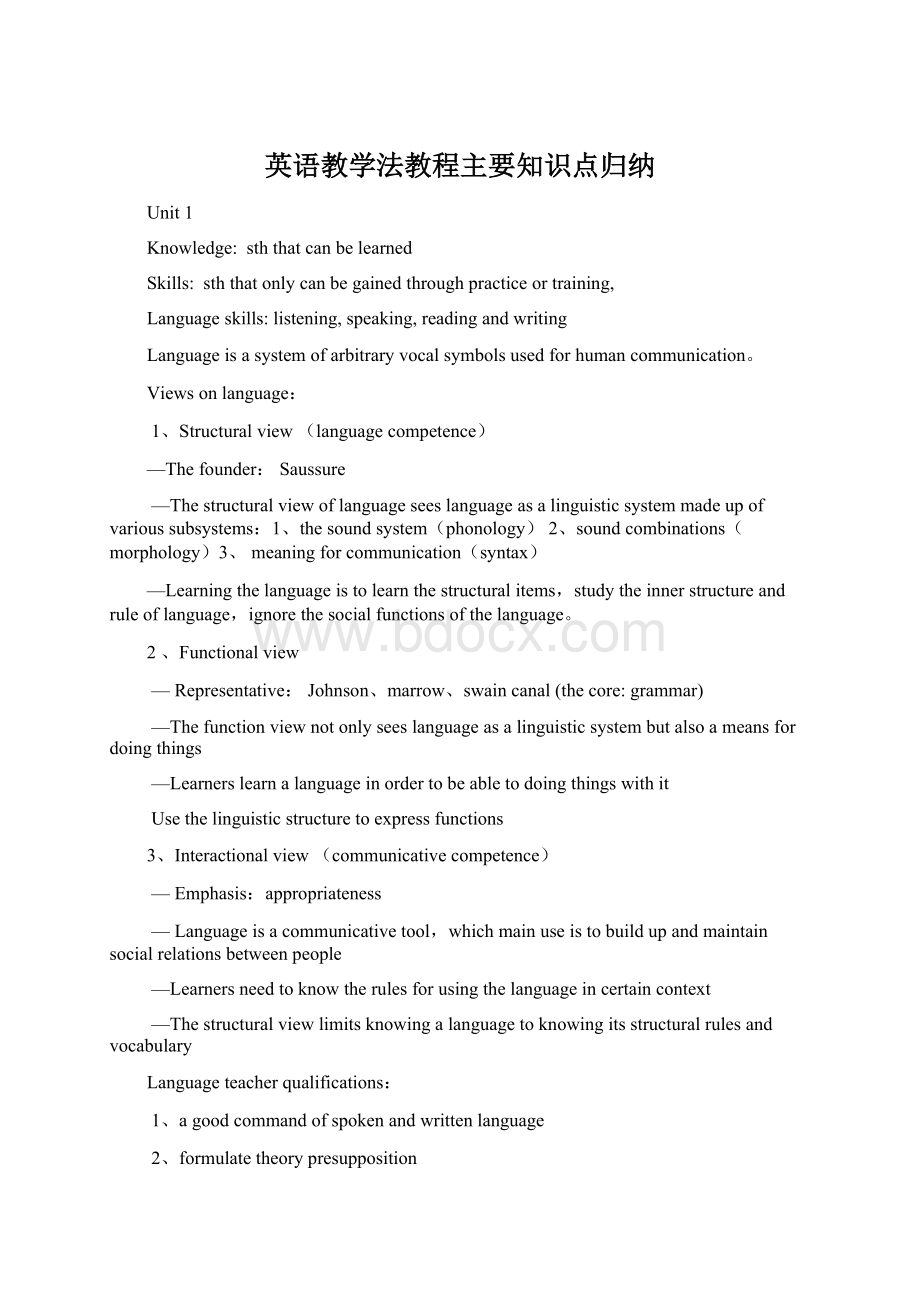英语教学法教程主要知识点归纳.docx
《英语教学法教程主要知识点归纳.docx》由会员分享,可在线阅读,更多相关《英语教学法教程主要知识点归纳.docx(15页珍藏版)》请在冰豆网上搜索。

英语教学法教程主要知识点归纳
Unit1
Knowledge:
sththatcanbelearned
Skills:
sththatonlycanbegainedthroughpracticeortraining,
Languageskills:
listening,speaking,readingandwriting
Languageisasystemofarbitraryvocalsymbolsusedforhumancommunication。
Viewsonlanguage:
1、Structuralview(languagecompetence)
—Thefounder:
Saussure
—Thestructuralviewoflanguageseeslanguageasalinguisticsystemmadeupofvarioussubsystems:
1、thesoundsystem(phonology)2、soundcombinations(morphology)3、meaningforcommunication(syntax)
—Learningthelanguageistolearnthestructuralitems,studytheinnerstructureandruleoflanguage,ignorethesocialfunctionsofthelanguage。
2、Functionalview
—Representative:
Johnson、marrow、swaincanal(thecore:
grammar)
—Thefunctionviewnotonlyseeslanguageasalinguisticsystembutalsoameansfordoingthings
—Learnerslearnalanguageinordertobeabletodoingthingswithit
Usethelinguisticstructuretoexpressfunctions
3、Interactionalview(communicativecompetence)
—Emphasis:
appropriateness
—Languageisacommunicativetool,whichmainuseistobuildupandmaintainsocialrelationsbetweenpeople
—Learnersneedtoknowtherulesforusingthelanguageincertaincontext
—Thestructuralviewlimitsknowingalanguagetoknowingitsstructuralrulesandvocabulary
Languageteacherqualifications:
1、agoodcommandofspokenandwrittenlanguage
2、formulatetheorypresupposition
3、languagebackgroundandexperience
4、knowhowlanguagesarelearnt
5、theabilitytousemethodsinvarioussituations
6、deepunderstandingofculturalbackground
7、understandingtheprinciplesofteaching
Theseelementscanbecategorizedintothreegroups:
ethicdevotion,professionalqualitiesandpersonalstyles
Viewonlanguagelearning
1.Psycholinguistic:
therelationshipbetweenlanguageandthinking.
1)Thinkinginlanguage
2)Languageisnecessaryforthought.
3)Languageacquisition(语言习得)
4)Learnersintheirearlieryearsacquirecontroloveressentialstructureoftheirlanguagewithoutspecialteachingandlearninginaeffortlessandalmostanunconsciousway(liketheformationofahabit)peoplepreferfirstlanguageacquisitiontofirstlanguagelearning.
2.Cognitivetheory:
theruleforpeopletoawaretocognizesth.
Cognitiveprocesses:
Process:
input----absorb----output
Languagelearningisnotjuststimulate-reflection,buttheusingofoursubjectivecapabilities,theusingofourcognitiveabilitytothinkthelanguageandstudyingitactively.
3.Constructivisttheory:
learningisaprocessofmeaningconstructionbasedonlearner’sownknowledgeandexperience.
S----------AT------------R
(刺激)(反应)
Stimulus:
assimilation①andaccommodation②
1把外部知识纳入自身
2纳入自身后也不相符,就要对原有知识进行改变,也就是一种原有知道和外部知识保持联系的创新的过程。
Unit2
1.CLT(交际英语教学):
itisanapproachthatconsidersthefunctionalandsocialfactorsinlanguage,emphasizesthattheaimoflanguageteachingistohelpthelearnersacquirecommunicativeability.Itoffersaneffectivewaytolearnlanguagethroughlanguageuse.
Thebasis:
thetheoryofsociologyandsociolinguistic.
2.Languagehastwofunctions:
A.thetransactionalfunction→toexpressthecontextB.theinteractional(相互影响的)function→toshowsocialrelationsandpersonalattitude
Languageisusedtoperformcertaincommunicationfunctions;useallskills:
A.Receptiveskill:
listeningandreadingB.Productiveskill:
speakingandwriting;usedinacertainsocialcontext:
teachthepartoflanguageinrealliferatherthanallthelanguagestudentsdevelopallthelanguageskills.
3.Traditionalpedagogy(传统教学法):
focusontheformsoflanguage.
4.TraditionalclassVS.CLT
Listening:
totheteacher,tothetape→sth.unpredictable,sth.authentic,sth.meaningful
Reading:
learninglanguage→getinformation,exactmeaning,differentskills
Speaking:
repeating,answering,retelling→sth.creating,expressoneself
Writing:
composition,translation→writetoexpressoneself,one’sfeeling,one’sthought;writewhatpeoplewriteinthewaypeoplewrite.
5.LinguisticCompetence(=languagecom.)
Chomsky:
tacitknowledgeoflanguagestructuresandtheabilitytousetheknowledgetounderstandandproducelanguage.
6.CommunicativeCompetence
Bothknowledgeaboutthelanguageandtheknowledgeabouthowtousethelanguageincommunicativesituationappropriately.
7.FeaturesofCLT:
1.focusondevelopingcommunicativecompetence
2.Focusonusefulandnecessarylanguage
3.Payattentiontothecommunicativetask
4.Placeimportanceonstudents'beingfluent
5.Encouragestudentstotakepartinactivities
6.Understandthestudentsareofdifferentstand
7.AwarethatthereisnotjustonekindofEnglish
8.MeritsofCLT:
1.likelytogivethestudentsallskills
2.Morerelevant
3.Lesswasteoftimeandeffort
9.DemeritofCLT:
1.makegreatdemandsupontheprofessionaltrainingandskillsoftheteacher
2.Difficulttocheekwhatstudenthaveleart
3.Don'toffertheteacherthesecurityofthetextbook
Unit4
1.Whatisteaching?
Teachingmeansensuringthatthestudentshavelearntormasteredwhatisbeingtaughtthroughapropersequenceofsteps,sotheteachershouldcarefullypreparethelessons,arrangethesteps,madefulluseofeverysecondinclass.
2.Principlesforgoodlessonplanning
A.AimB.VarietyC.FlexibilityD.learningabilityE.linkage
3.Macroplanninginvolvesthefollowing:
A.theanalysisoftheschool
B.theanalysisofthestudents(information,background)
C.theanalysisofthesyllables(教学大纲).(principle,purpose,requirement)
D.theanalysisofthetextbook(教材分析)
E.theteachingmethodsandreform(教学方法及其改革)
F.theteachingobjectiveandarrangement(整体教学目标及安排)
4.Componentsofalessonplan:
A.Backgroundinformation
BTeachingaims
C.Languagecontentsandskills
D.stagesandprocedures
E.Teachingaids
F.Endoflessonsummary
G..Optionalactivitiesandassignments
H.Afterlessonreflection
5.Howtomakeamicroplan.
A.Theteachingaimsanddemands(ability,knowledge)
B.Theteachingcontents
a.vocabulary,phrase
b.structure
c.grammar
d.skills
C.Theteachingimportantanddifficultpoints
D.Theteachingmethodsandaims
E.Theteachingprocedure
a.stage1:
warm-upactivities
b.stage2:
(step1:
presentation-------step2:
pratice-------step3:
production)
c.stage3:
lessonsummary
d.stage4:
assignments/optionalactivities
e.stage5:
afterclassreflection
Unit5
Ⅰ.Theroleoftheteacher(basedonthefunctionoftheteacher):
1.Controller:
controlthepace,thetime,thetargetlanguage,thestudent.
2.Assessor:
twothings
a.ascorrector:
correctthemistakes,organizingfeedbackthelearners
b.asevaluator:
tocreateasuccess-orientedlearning,atmosphere,morepraise,lesscriticism
3.Organizer:
taskbasedonteachingtodesigntasksandtoorganize
4.Prompter:
togiveappropriatepromptshints
5.Participant:
totakepartintheactivities
6.Resource-provide:
asawalkingdictionary
Ⅱ.Rulesformakinginstructionseffective:
1.simple2.natural3.targetlanguage/bodylanguage
4.givetimetogetusedtolisteningtoEnglish
5.Modelthetasks/activitiesbeforedoingthemclearinstructions
Ⅲ.Thecommonstudentgroupingsare:
a.wholeclasswork;b.pairwork;c.groupwork;d.individualstudy
Ⅳ.Disciplinereferstoacodeofconductwhichbindsateacherandagroupofstudentstogethersothatlearningcanbemoreeffective
哪些因素影响学生纪律:
1.teacher’sbehavior
a.choiceofmethodology
b.teacher’spreparationforthelearners
c.interpersonalrelationshipwiththelearners
2.motivation/purpose/desire/surrounding
Ⅴ.Howtomaintainthediscipline:
1.createacodeofbehavior
2.beconsistentinapplyingtherules
3.befriendlyandtalktostudents
4.immediatelyaction
5.befairtoeveryonedealwithproblemsimpersonally
Ⅵ.Measuresforindisciplinedactsandbadlybehavingstudents:
(P81)
1.actimmediately
2.stoptheclass
3.rearrangetheseats
4.changetheactivities
5.talktostudentsafterclass
6.createacodeofbahaviour
Ⅶ.Adviceaboutproblemsonclass:
(P81)
1.dealwithitquietly
2.don’ttakethingspersonally
3.don’tusethreats
Ⅷ.Questionintheclass
Purpose:
1.tofocusonthestudents’attention;
2.toinvitethinkingandimagination;tochecktheunderstanding;
3.tosimulatethestudentstorecallinformation;
4.tochallengestudents;
5.toassesslearning
Typesofquestion(P83)
1.closequestion-onlyoneanswer
2.openquestion-manydifferentanswer
…
Ⅸ.Dealingwitherrors
1.Mistake-----withnothingtodowithlanguagecompetence(causedbycarelessness→self-correction)
2.Error-----hassthtodowiththelanguagecompetence(causedbylackingofknowledge→bedealtwiththehelpoftheteacherandotherclassmates)
3.Dealingwithspokenerrors
a.fluencyactivity----aftertheactivity
b.accuracyactivity----whiletheactivity
4.Howtocorrect
a.indirectteachercorrection
b.directteachercorrection
c.self-correction
d.peer-correction
Unit6
1.Theroleofpronunciation
①2views:
a.pronunciationwilltakecareofitselfneedn’tteachpronunciation
b.poorpronunciationisagreathindranceinlanguagelearning
②ForChinese:
pronunciationisimportantdependon
a.ChineseisdifferentfromEnglish
b.ChinesehavelittleexposuretoEnglish
2.Thegoalofteachingpronunciation
①Wecannevergetthenative-likepronunciation
a.CriticalPeriodHypothesis
b.theamountofexposure
c.biologicalandphysiologicaldifferences
②ourrealisticgoalofteachingpronunciation(P93)
a.Consistencyb.Intelligibilityc.Communicativeefficiency
3.Aspectsofpronunciation
①